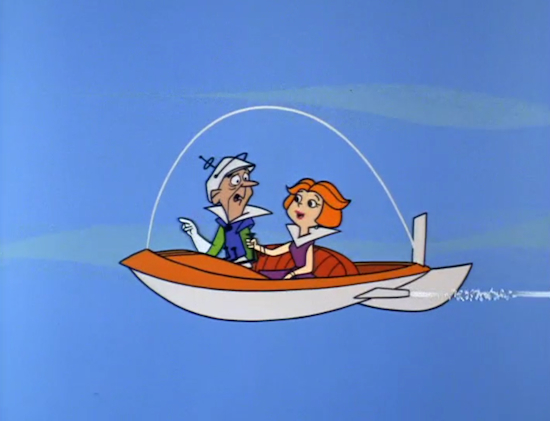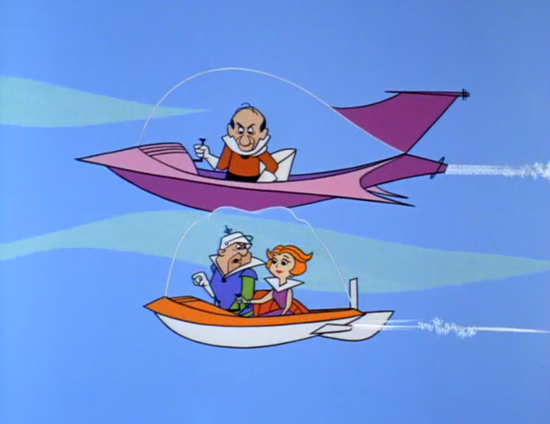“The problem with these skyways is that by the time they’re built they’re obsolete. This traffic is the worst I’ve seen yet,” George Jetson proclaims as he zips around in his flying car.
The 18th episode of “The Jetsons” originally aired on January 27, 1963, and was titled “Jane’s Driving Lesson.” With a title like that one might expect that the episode deals with flying cars in the year 2063. Specifically, female drivers of the year 2063.

Jane Jetson gets a driving lesson in the 18th episode of “The Jetsons” (1963)
The episode is proudly sexist at every turn as it played for laughs while men appeared constantly terrified of women behind the wheel — or the yoke as the case may be. George pulls up behind a young woman driver and becomes confused by her hand signals. “Women drivers, that’s the problem!” George shouts at the woman.
When we looked at the 15th episode of “The Jetsons,” titled “Millionaire Astro,” The social and economic conservatism of the show was showcased. The 18th episode is another example of the show’s conservatism, not in terms of a “red state versus blue state” political sense but its affirmation of the social status quo.
Where did the myth that women are worse drivers than men come from?
Michael L. Berger writes in his 1986 paper “Women Drivers!: The Emergence of Folklore and Stereotypic Opinions Concerning Feminine Automotive Behavior” about the history of the stereotype that women are poor drivers. Much like in the way that the “women are bad drivers” jokes are presented in “The Jetsons,” there is a long history of using humor to perpetuate this sexist rhetoric:
For although often presented in a humorous context, folklore concerning women drivers, and the accompanying negative stereotype emerged for very serious social reasons. They were attempts to both keep women in their place and to protect them against corrupting influences in society, and within themselves.As Berger points out in his paper, the idea of women as bad drivers was rooted in class and wealth. The stereotype did not gain traction until the 1920s, when middle class American women began to access automobiles. Until then, only a wealthy handful - male or female - could afford a luxury such as a car:
As long as motoring was limited to wealthy urban women, there was little criticism of their ability as drivers. These were women of high social and economic station, who made a vocation of leisure-time pursuits. If they chose to spend their time motoring around the city rather than at home giving teas few would criticize. Such changes posed little or no threat to the established social order, and hence there was no need for a negative stereotype.In the 1910s prices of cars were coming down and many men were leaving to fight the first World War, women had both the “need and opportunity” to learn to drive for those who had not already:
By the end of [WWI], there existed the real possibility that the automobile could be adopted by large numbers of middle-class women. It is from this period, and not that of the initial introduction of the motor car, that we can trace the origins of the women driver stereotype and the folklore of which it is a part.Jane Jetson was very much the American middle-class everywoman of 2063 — the woman that women of 1963 were supposed to identify with on the show, and in turn the woman that girls of 1963 were supposed to see as their future.

Jane’s driving was so bad, even a bank robber begged to be in jail rather than spend more time in the car with her.
Jane receives a driving lesson during the episode but when the instructor wants to stop off to check his safe deposit box and life insurance policy, a bank robber emerges and jumps in. Jane continues driving, believing he must be another driving instructor. The bank robber is terrified of Jane’s driving and by the end of the episode is begging to be put in jail rather than endure more time in the flying car with Jane.
After George finds Jane at the police stations the status quo is restored (George is again behind the yoke) and Jane explains, “You know George, I don’t really care much about driving anyway.”
George responds, “Well, it’s probably better if you don’t Janey. Driving requires a man’s skill; a man’s judgement; a man’s technical know-how.”
“And what about a man’s eyesight, George?” Jane replies just before George realizes he went through a red light and crashes into a parked car. This, like so many of these “women are bad at stuff” tropes from midcentury sitcoms, is meant to be the kicker. The audience is given a sly wink — isn’t it ridiculous that a man could be just a terrible as a woman behind the wheel?
Thanks to an unsympathetic judge (the parked car George plowed into was owned by the judge) George has to start taking the flying bus. Interestingly, the only other time in the series that we see a bus stop (other than early in this episode) is in the first episode, when Rosey tries to sullenly run away.

George waiting at the bus stop after his driver’s license is suspended (1963)
Much like other episodes of “The Jetsons,” we are left to wonder what kind of real-world impact a different depiction of the future may have had on the world we live in today. Obviously, the episode is little more than one long “women are terrible drivers” joke and it is easy to dismiss it as such, but it was seen repeatedly throughout the 1960s, ’70s and ’80s by children everywhere. Time and again we see “The Jetsons” used as a way to talk about the future in which we now live.
No comments:
Post a Comment